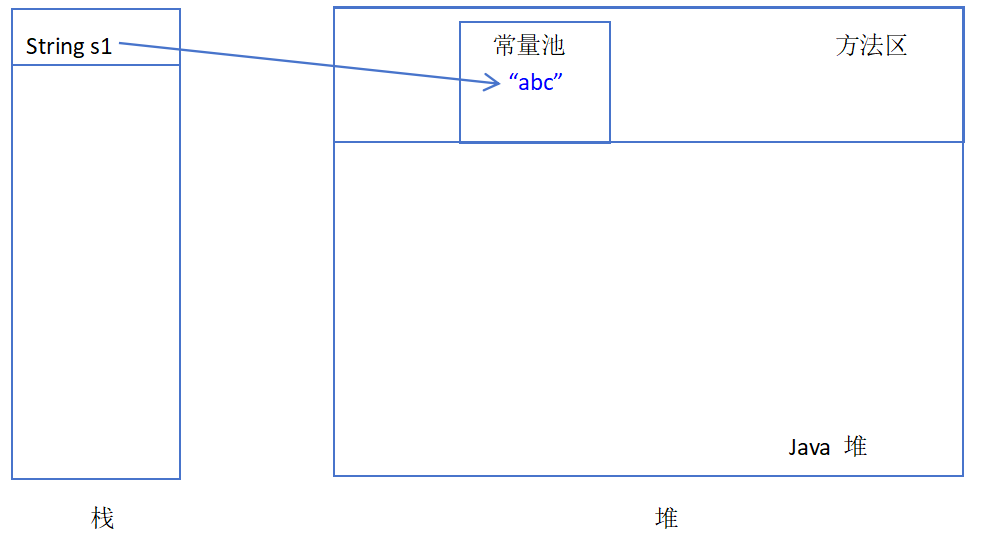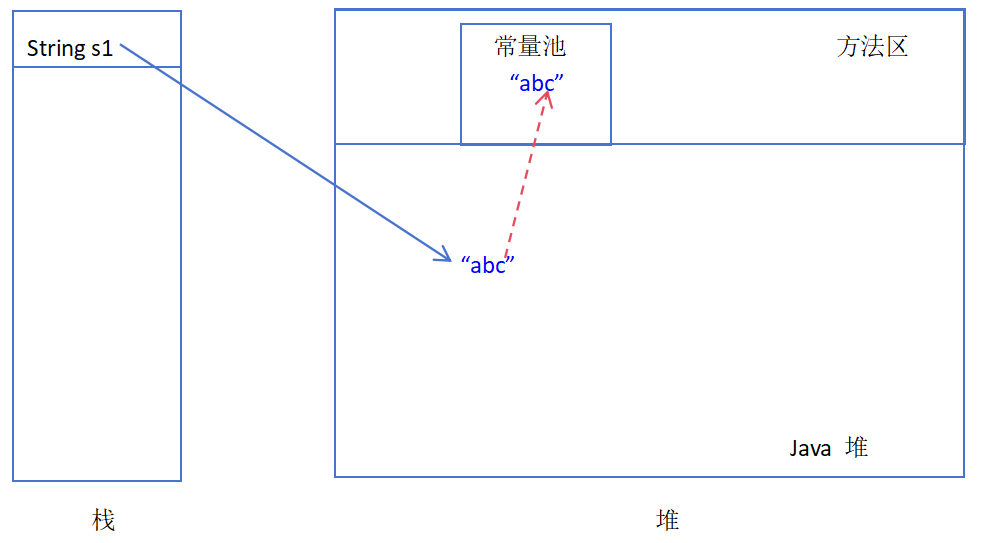“abc”、new String(“abc“)、“a”+“b“=“ab“、常量池
发布时间:2023年12月27日
“abc”
如果常量池存在“abc”常量
变量s1指向常量池的"abc"
如果常量池不存在"abc"常量
常量池先创建"abc",然后变量s1指向常量池的"abc"

new String(“abc”)
如果常量池存在“abc”常量
将“abc”拷贝到Java堆,变量s1指向Java堆的"abc"
如果常量池不存在"abc"常量
常量池先创建"abc",然后将“abc”拷贝到Java堆,变量s1指向Java堆的"abc"

思考题
问题
public static void main(String[] args) {
String s1 = "hello";
String s2 = new StringBuilder("he").append("llo").toString();
String s3 = s2.intern();
String s4 = "hello";
System.out.println(s1 == s2); // false
System.out.println(s2 == s3); // false
System.out.println(s3 == s4); // true
}
分析
s1 = "hello",将"hello"放入方法区,并且s1指向"hello"。s2获取到了“hello”,但是这并不是从方法区获取的"hello",
s3=s2.intern()是将s2的"hello"与方法区进行对比,如果存在"hello",那么就返回原来"hello"的方法区地址,
否则放入方法区并返回新的方法区地址。这里因为方法区已经有"hello",所以返回了以前的地址,所以s2 != s3。
s4 = "hello",指向了方法区的"hello"的地址。
再看一下下面的例子
String s2 = new StringBuilder("he").append("llo").toString();
String s3 = s2.intern();
String s4 = "hello";
System.out.println(s2 == s3); // true
System.out.println(s3 == s4); // true
文章来源:https://blog.csdn.net/m0_46638350/article/details/135239560
本文来自互联网用户投稿,该文观点仅代表作者本人,不代表本站立场。本站仅提供信息存储空间服务,不拥有所有权,不承担相关法律责任。 如若内容造成侵权/违法违规/事实不符,请联系我的编程经验分享网邮箱:chenni525@qq.com进行投诉反馈,一经查实,立即删除!
本文来自互联网用户投稿,该文观点仅代表作者本人,不代表本站立场。本站仅提供信息存储空间服务,不拥有所有权,不承担相关法律责任。 如若内容造成侵权/违法违规/事实不符,请联系我的编程经验分享网邮箱:chenni525@qq.com进行投诉反馈,一经查实,立即删除!
最新文章
- Python教程
- 深入理解 MySQL 中的 HAVING 关键字和聚合函数
- Qt之QChar编码(1)
- MyBatis入门基础篇
- 用Python脚本实现FFmpeg批量转换
- 在线AI照片转动漫工具,快速、免费且隐私保护
- K8S学习指南(22)-k8s核心对象Endpoint
- [笔记]学习做微信小程序
- 你竟然还不知道SQL性能分析?(你想象不到的详细)
- 拼图小游戏(实现游戏主界面)(未连接数据库)
- 堆排序——C/C++
- 【学习笔记】[AGC043F] Jewelry Box
- Elasticsearch:相关性工作台 - BM25 及 ELSER 的相关性比较
- 《Kotlin核心编程》笔记:可空类型&平台类型&装箱类型&数组类型&泛型&协变与逆变
- 迭代器模式介绍